Key Concepts and Summary
Catalysts affect the rate of a chemical reaction by altering its mechanism to provide a lower activation energy. Catalysts can be homogenous (in the same phase as the reactants) or heterogeneous (a different phase than the reactants).
Practice Problems: Catalysts
Explain how a catalyst acts to increase reaction rate.
Solution
Generally, a catalyst will provide a new reaction mechanism by which the reactants can unite more readily – creating a reaction path with a lower reaction energy. The rates of both the forward and the reverse reactions are thereby increased. The reaction will be able to reach equilibrium faster (as well as be observed to have a faster instantaneous reaction rate).
Compare the functions of homogeneous and heterogeneous catalysts.
Solution
Both types of catalysts will cause an increase in rate of reaction by reducing the Ea in the reaction mechanism. Homogenous catalysts exist in the same phase of matter as the reactants. For example, H+ in solution can act as a catalyst to many reactions between other aqueous species. Heterogenous catalysts exist as a separate phase, most commonly as solids to a gaseous or aqueous reaction. Palladium particles in a catalytic converter (where the gaseous products of combustion pass over and are decomposed) are an example of a heterogenous catalyst.
How can you tell whether two reaction coordinate diagrams show the same reaction proceeding through two different mechanisms, or two different reactions?
Solution
If the reaction is the same then the enthalpy of the reaction cannot change. If the reaction is the same, then the ΔH (or ΔG) of the reaction must be the same, regardless of its reaction mechanism. Also, since the identities of the reactants and products must be the same if the reaction is the same, the absolute values of the initial and final energies (in kJ/mol) of the reactants and products must stay the same, although any intermediates or transition states can change depending on the mechanism.
Consider this scenario and answer the following questions: Chlorine atoms resulting from decomposition of chlorofluoromethanes, such as CCl2F2, catalyze the decomposition of ozone in the atmosphere. One simplified mechanism for the decomposition is: $$O_3\;^{\underrightarrow{\;sunlight\;\;}}\;O_2+O$$ $$O_3+Cl \rightarrow O_2+ClO$$ $$ClO+O \rightarrow Cl+O_2$$
(a) Does this mechanism confirm that chlorine atoms are a catalyst in the gas-phase transformation of ozone to dioxygen?
Solution
Chlorine atoms are indeed a catalyst in this reaction mechanism because they react in the second step but are regenerated in the third step.
(b) Nitric oxide is also involved in the decomposition of atmospheric ozone by the mechanism: $$O_3\;^{\underrightarrow{\;sunlight\;\;}}O_2+O$$ $$O_3+NO\rightarrow NO_2+O_2$$ $$NO_2+O\rightarrow NO+O_2$$
Is NO a catalyst for the decomposition of ozone in this mechanism? Explain your answer.
Solution
Yes, NO is a catalyst, following the same logic as the Cl in part (a).
For each of the following reaction diagrams, estimate the activation energy (Ea) of the reaction:
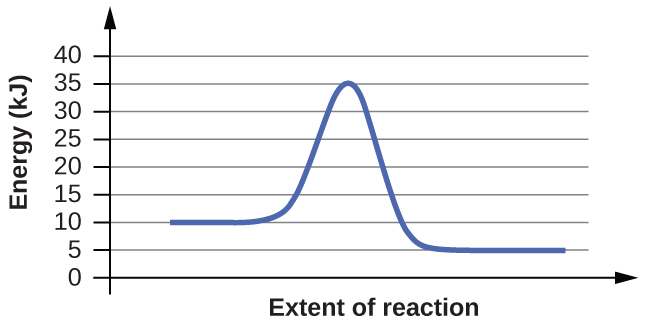
Solution
The activation energy is approximately 25 kJ.
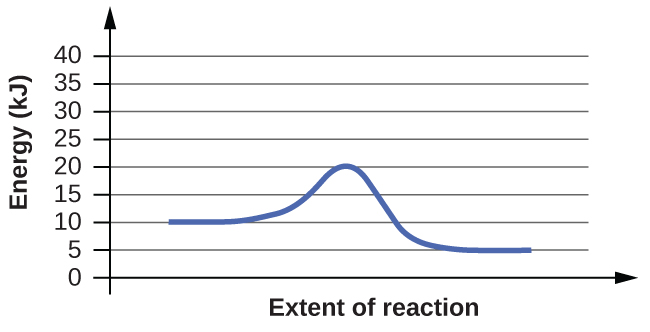
Solution
The activation energy is approximately 10 kJ.

Solution
The activation energy is approximately 10 kJ (based on the first step, which will be the rate-determining step of the reaction – the second step’s Ea is only ~5 kJ).
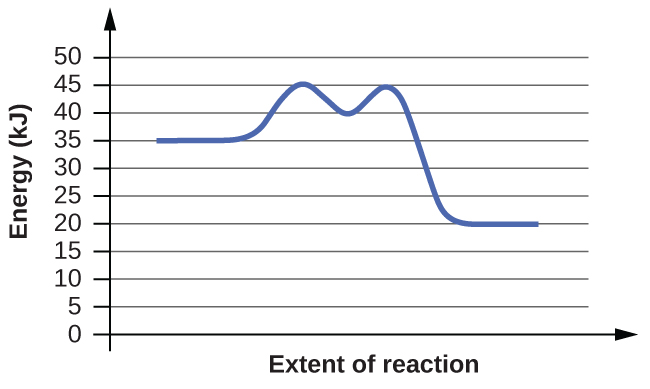
Solution
The activation energy is approximately 10 kJ (based on the first step, which will be the rate-determining step of the reaction – the second step’s Ea is only ~5 kJ).
Each pair of reaction coordinate diagrams below represents two versions of the same reaction: one catalyzed and one uncatalyzed. In each pair, identify which of the reactions shown is catalyzed:

Solution
Diagram (b) shows the reaction with the lowest activation energy; it is more likely to be the catalyzed reaction.
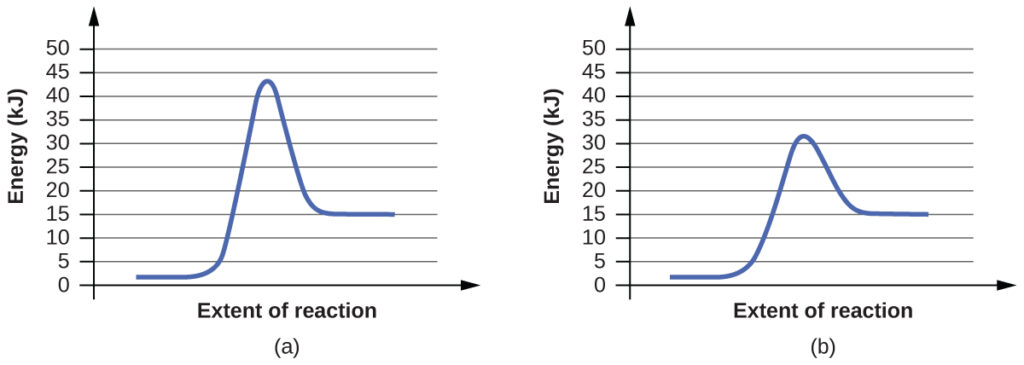
Solution
Diagram (b) shows the reaction with the lowest activation energy; it is more likely to be the catalyzed reaction.
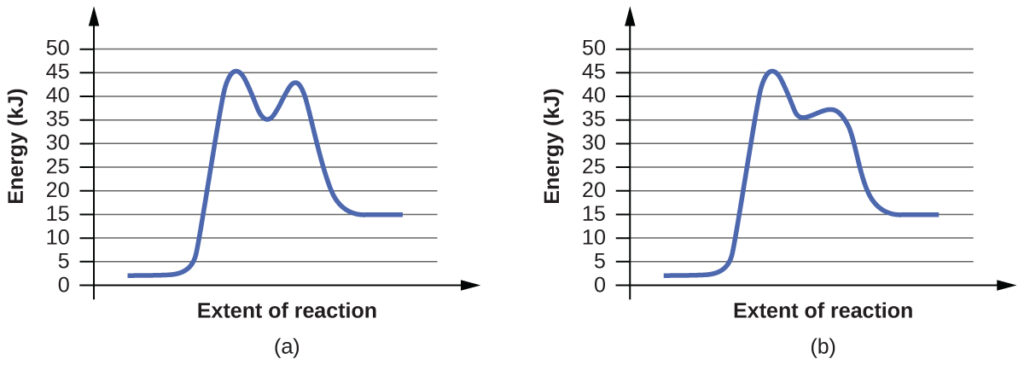
Solution
Both reactions have a first (slow) step with a similar Ea. Changes to the overall rate of reaction by altering only the second step will be negligiable. However, diagram (b) shows the second step in the reaction with the lower activation energy; it is more likely to be the catalyzed reaction.
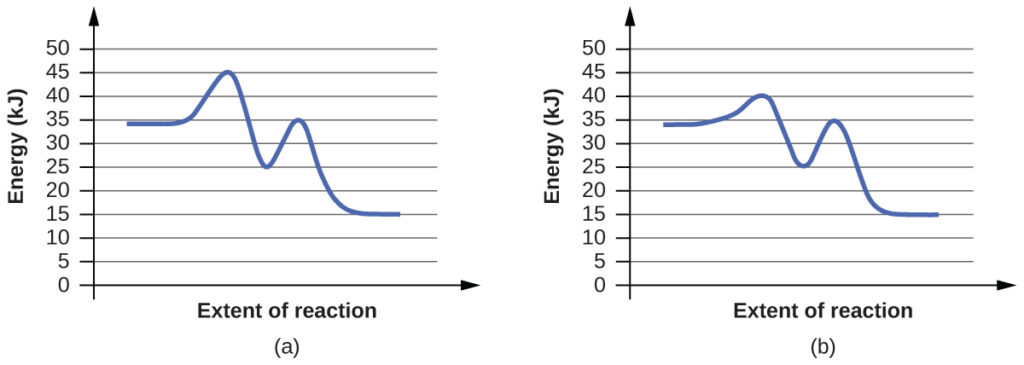
Solution
In (a), both reaction steps have a similar Ea (about 10 kJ). Based on the position of the lines, the first step may be slightly larger than the second, making it the rate determining step. The activation energy of this step is reduced in (b): the reaction shown in (b) will proceed faster and is the catalyzed reaction.
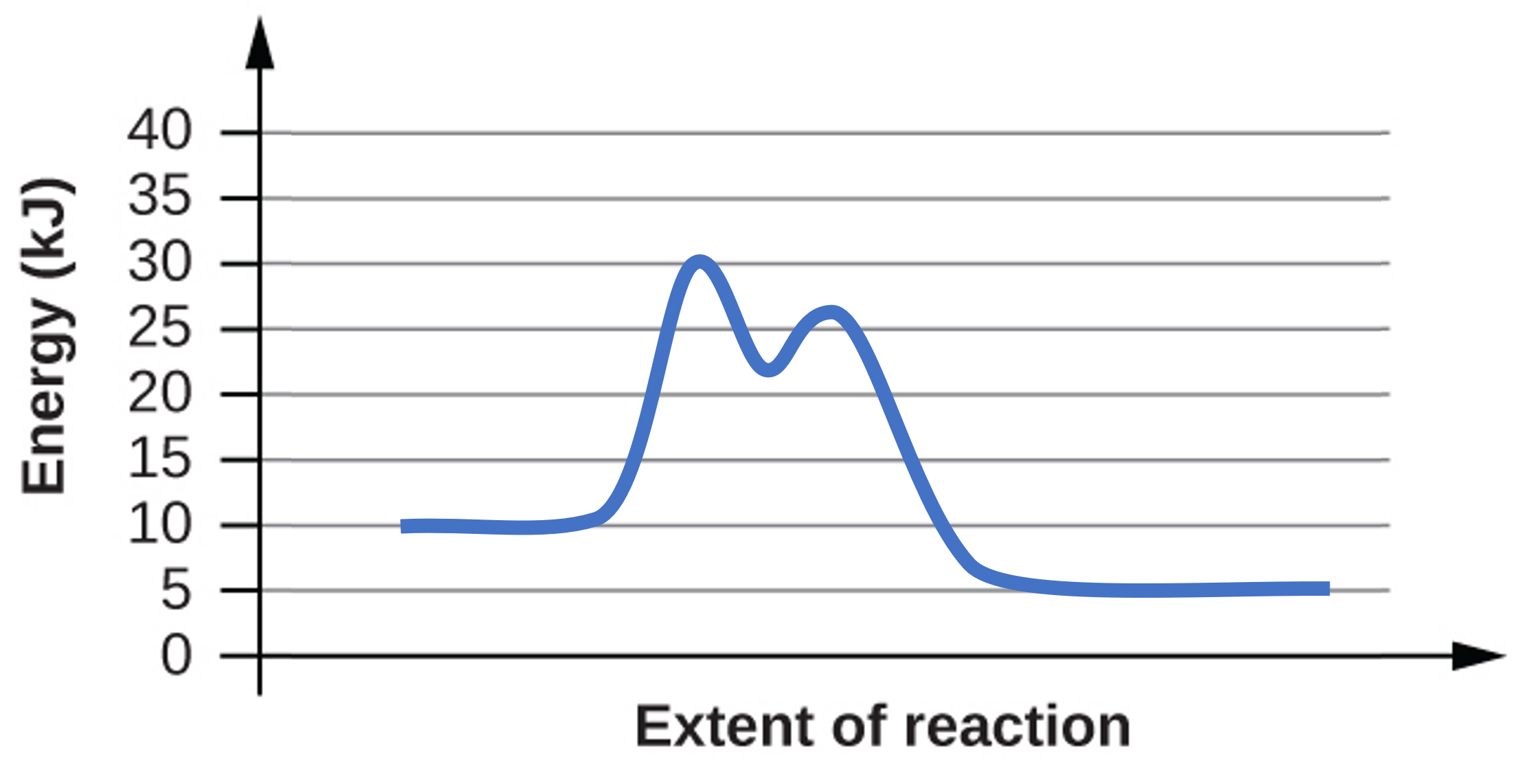

Solution
The right-hand figure has a larger activation energy for its single step than the rate-determining step (first step) in the reaction shown on the left. The left-hand diagram shows the catalyzed reaction.
Glossary
- catalyst
- substance that increases the rate of a reaction (by lowering the ovreall activation energy) without itself being consumed by the reaction
- heterogeneous catalyst
- catalyst present in a different phase from the reactants, furnishing a surface at which a reaction can occur
- homogeneous catalyst
- catalyst present in the same phase as the reactants